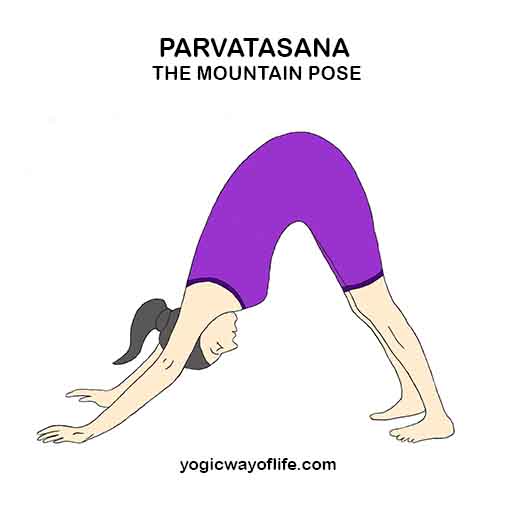Parvatasana or the Mountain pose is part of the Sun Salutation series of asanas. It appears as the 4th pose and the 9th pose in the Sun Salutation or Surya Namaskara. In Sanskrit “Parvata’ means mountain. The pose looks like a mountain from the sides and hence the name Parvatasana.
Parvatasana can strengthen the wrists and legs. It also increases the flow of blood to the head.
How to do Parvatasana (The Mountain Pose)?
- As part of the Surya Namaskara, Parvatasana is performed after Ashwa Sanchalanasana or the equestrian pose. Hence Ashwa Sanc halanasana becomes the starting pose for Parvatasana.
- From Ashwa Sanchalanasana, straighten the bend leg and take it backwards. Exhale during this process. Let the right and left foot be together.
- Raise the buttocks up. Let the two arms be on the floor and support the body weight. Lower the head to be between the two arms. The body makes the shape of a triangle when observed from the sides. It looks like a mountain and hence the name.
- When done as part of the Surya Namaskara (Sun Salutation exercises) a mantra can be chanted while performing this asana. Parvatasana is done as the 4th pose and the 9th pose. The mantra to be chanted is given below:During 9th pose chant “Om Marichaye Namaha”. It means salutation to the lord of the dawn.
- During 4th pose chant “Om Khagaya Namaha”. It means salutations to the one who moves in the sky.
Benefits of Parvatasana (The Mountain Pose)
- Parvatasana strengthens the muscles of the arms and legs.
- It tones the spinal nerves and sends good flow of blood to the spinal region.
- It increases blood flow to the brain and gives mild benefits similar to inverted asanas.
Contraindications for Parvatasana (The Mountain Pose)
- Parvatasana should not be done if you have any wrist, hip or ankle injury.

